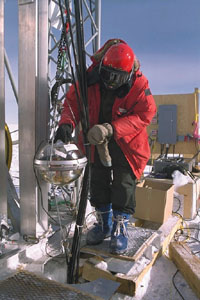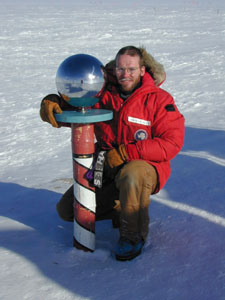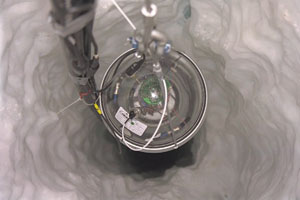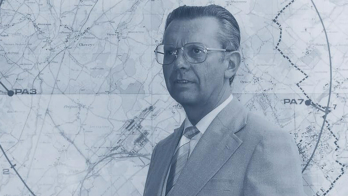Physics student Torsten Schmidt of DESY Zeuthen regularly undergoes the ultimate terrestrial physics experience – living and working at the South Pole with the AMANDA neutrino experiment. In this interview, he describes polar life.
In September 1997, PhD student Torsten Schmidt began working at DESY Zeuthen, near Berlin. Three months later he was visiting the realm of perpetual ice at the South Pole. The 30-year-old has now been to Antarctica four times to help to build the neutrino telescope AMANDA-II, most recently in December 2000. CERN Courier asked him about his experiences.
Is it difficult to endure three to four weeks at the Pole?

It varies from person to person. I really like it there. Four weeks is a good time limit. As far as life at the station goes, you could hold out for longer, but since you go down there to work, you keep working more or less continuously for the whole four weeks.
So there’s no time left to have a look around?
There isn’t much to see there, actually. It’s flat, cold and there are at most two “sights” worth seeing: a crashed aeroplane at the end of a runway, which is a trip of two to three hours; and a ski cabin about 10 km away – but trips there will be prohibited next season.
Why is that?
The pole is run by a company, and the company – for whatever reason – has stopped allowing people to go there.
So a company runs the South Pole?
To be more exact, the company was hired by the US National Science Foundation to take care of transportation, logistics and operations. NSF is the real host of the Amundson-Scott station and determines the various science programmes at the Pole.
Another example of a prohibited location is the old station, which was abandoned in the early 1970s. It’s located in the so-called dead sector, which in reality means that anyone who goes there will be on the next plane north and won’t be allowed back to the Pole ever again. It’s simply too dangerous there. The station has been standing there deserted for over 30 years. It’s covered with snow and ice and could collapse at any time.
Isn’t it much too cold, in the winter at least, to do any work outside?

Well, it does get very cold, but in the first few weeks after the last plane left there were days when it was only -40 °C. Deepest winter temperatures are around -80 °C.
Is the new station right at the Pole?
Yes, but so was the old one at one time. The ice actually moves about 10 m each year. So every year on New Year’s Eve, the “new” South Pole is measured, and on New Year’s Day a post is driven into the ice at that point. That’s always a big party for the whole station.
There are, in general, many social events. One might think that it’s boring and lonely at the Pole, but that’s not true. There’s something going on every day. That’s because only 50 of the 250 people who live there are scientists. The rest are “support” people: electricians, roofers or crane operators, both men and women. They work their 8 to 10 hours a day and then they’re done – unlike us researchers. And, of course, they want to enjoy their leisure.
So there are weeks and weekends. What about days and nights?

There is, so to speak, a day and a night for the support people because of their shifts, but there are no routine hours for us researchers. Of course, when work is done in the group, a time has to be agreed upon, but otherwise you’re completely free in that regard. You can’t sleep much anyway because the sun is always shining, but there are hot meals every six hours.
I can live any way that I want, which is something I like very much. If I don’t have to work with other people, then I work for as long as I can, and then go to sleep and lose all sense of time in a flash.
How many hours do you work and sleep in that kind of system?
On average, it’s 12-15 hours of work a day, but if necessary we can work for as long as 30 hours non-stop. After that come five hours of rather fitful sleep. It’s hard to rest any longer. We sleep in huge military tents with about 20 people in each. And since it’s always daytime, there’s no regular lights-out time either.
The result is that people are constantly trudging through the tent in heavy boots and slamming the door. Outside, aeroplanes are landing around the clock. You really have to be dead tired to be able to sleep at all.
The tents must make the place look like a campsite.
Actually, the Amundsen-Scott station is a high-tech place, with a huge metallic dome and several elevated houses. The summer population, however, lives in those 20-30 tents. In the middle is the bathhouse, which includes a very well frequented toilet – the reason being that the dry air means you need to drink as much and as often as possible. But it’s unpleasant when you’ve just lain down to sleep and then have to go outside again – in your whole outfit including trousers, boots and anorak. How often have I cursed that toilet! Some people avoid the trip and put a bottle next to their beds.
What other problems does the Pole novice have to reckon
with?

Along with the small amount of sleep, there’s also the physical strain because of the high altitude. After all, the station is nearly 3000 m above sea level. The air is thin, cold and dry, and you become dehydrated very quickly.
Things are particularly bad in the first few days: every step is a strain; you collapse into bed wearily but still can’t sleep. Even the small climb of 5 m at the exit of the winter camp makes newcomers break into a sweat.
After the weariness has faded, you live very well at the Pole for a few weeks, but then you start to feel the lack of sleep and the exhaustion from the work. At that point it’s time to begin the trip home.
Are there moments that allow you to forget all of the exertions of polar life?
One particularly nice social event is Christmas, of course. Christmas at the Pole is really good fun. On Christmas Eve the Americans organize a party. On Christmas morning there’s the “race around the world” – three laps around the South Pole. After that comes the Christmas meal, which is actually served three times because the team is so large.
New Year’s Eve is naturally a big celebration too. Last time some of the hard-core types even celebrated the New Year in a different time zone every hour – that’s possible at the Pole.
Other highlights last season were bocci-ball and golf. We also go to the sauna at least once a year and then run around the South Pole almost naked.





